

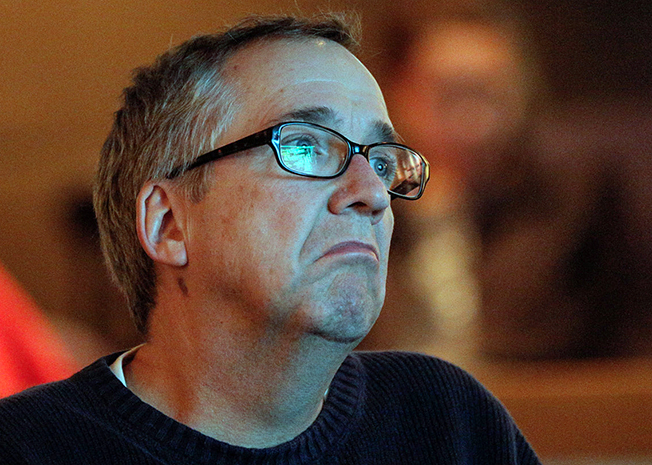
Photo by Loren Elliott/CPoY
CPoY judge John Sale ponders a final round decision on Nov. 12, 2014. Sale is the visuals editor at The Commercial Appeal in Memphis, Tenn.
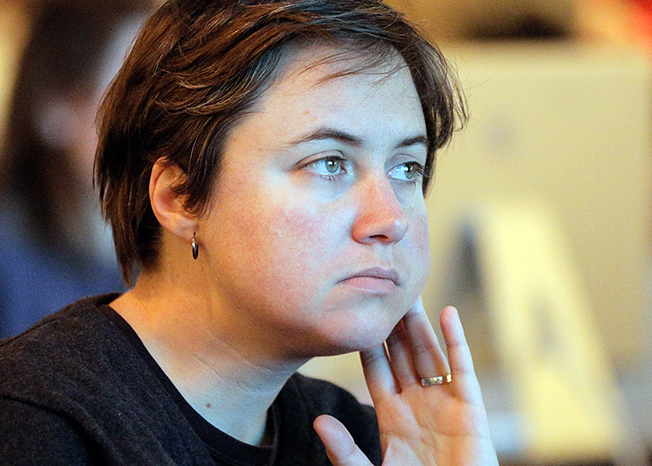
Photo by Loren Elliott/CPoY
Preston Gannaway takes a minute with her fellow CPoY judges to contemplate final round advances on Nov. 12, 2014. Gannaway is a Pulitzer Prize winning documentary photographer.
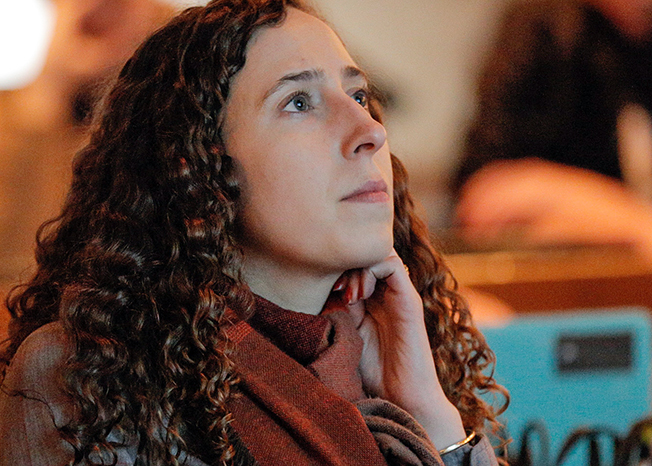
Photo by Loren Elliott/CPoY
Judge Jessie Wender takes in the first round of images during the CPoY contest on Nov. 12, 2014. Wender is a senior photo editor at National Geographic.
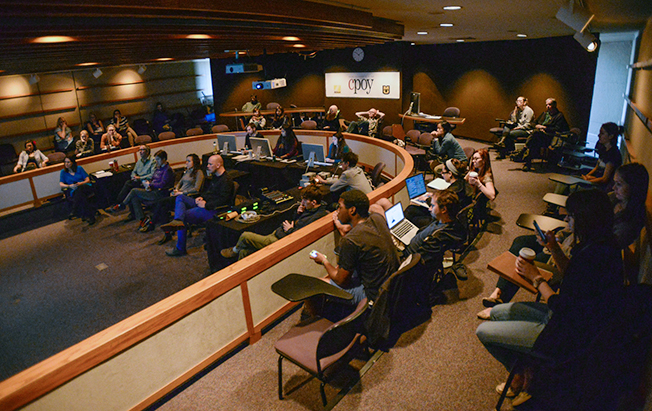
Photo by Loren Elliott/CPoY
Judges and attendees look on during the final round of judging for the College Photographer of the Year Sports Feature category on Nov. 10, 2014.
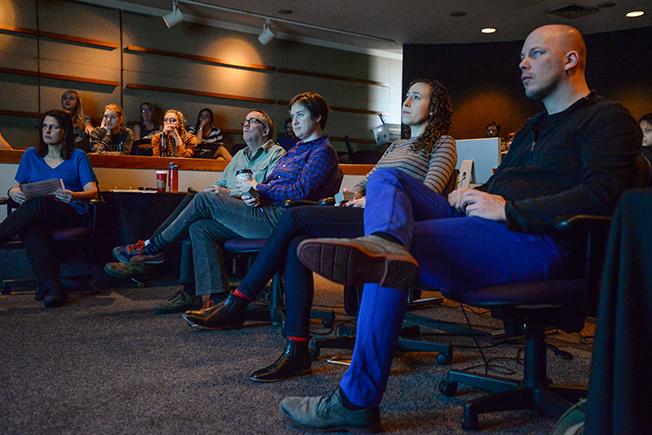
Photo by Loren Elliott/CPoY
From right to left, judges Uwe Martin, Jesse Wender, Preston Gannaway and John Sale view the Sports Feature category on CPoY's second day of judging Monday, Nov. 10, 2014.



Photo by Loren Elliott/CPoY
CPOY coordinator Taz Lombardo toggles through images displayed on the big screen during the first day of judging Sunday, Nov. 9, 2014.
Photo by Loren Elliott/CPoY
University of Missouri photojournalism graduate students Justin Stewart (left) and Alexey Furman watch the judging process at the 69th annual CPoY's first day, on Nov. 9, 2014. "Justin and I were playing the 'ins' and 'outs' game, pointing our thumb up or down depending on what we thought about the image on the screen," Furman said. "It was interestin g as on most of the images our opinions were contrary. I think neither of us did good in guessing the judges' opinion."
Photo by Loren Elliott/CPoY
CPoY judges and coordinators take part in the first day of judging on Nov. 9, 2014. "Students at MU are particularly fortunate to have a photojournalism competition like this hosted here," University of Missouri senior Sarah Rothberg said. "Viewers have the opportunity to hear experts in the field comment on photos taken by our peers. Personally, I've been participating in the competition for two to three years, and it's been an invaluable experience."
Photo by Loren Elliott/CPoY
CPoY director Rita Reed (left) chats with judges Uwe Martin (center) and Preston Gannaway during a break in the judging at Tucker Forum on Nov. 9, 2014.
CPoY: What impact did winning cPOY have on your work or professional career?
Sleezer: Winning cPOY not only gave me confidence in my chosen career path, but gave me credibility within the photojournalism community. Along with it, came a summer internship at National Geographic when Rich Clarkson was the director of photography at the magazine. I had been following his ability to help and inspire photographers since his days in Topeka, Kansas, and had always wanted to work for him. Having that internship on my resume, along with internships at the Philadelphia Inquirer and Milwaukee Journal helped me decide that newspapers were going to be my chosen career.
CPoY: What is the latest photo project you've been working on?
Sleezer: About 75 percent of the work I do for the Kansas City Star is sports photography. The last project I finished was the 2014 Royals baseball season. My beat is covering the team throughout the season and this year was the first time since 1985 that the team played in the World Series. While a student at Kansas State University in the early to mid 1980s, I was the UPI stringer at the school. This allowed me to hone my skills in sports and news events. One of those skills was turning around photos quickly on deadline for UPI. As technology has changed, I have embraced the technology that allows for quick turnaround of pictures in time for deadline. This skill set is one that is needed today by photojournalists, as newspapers require more and more photos quickly for their websites and social media.
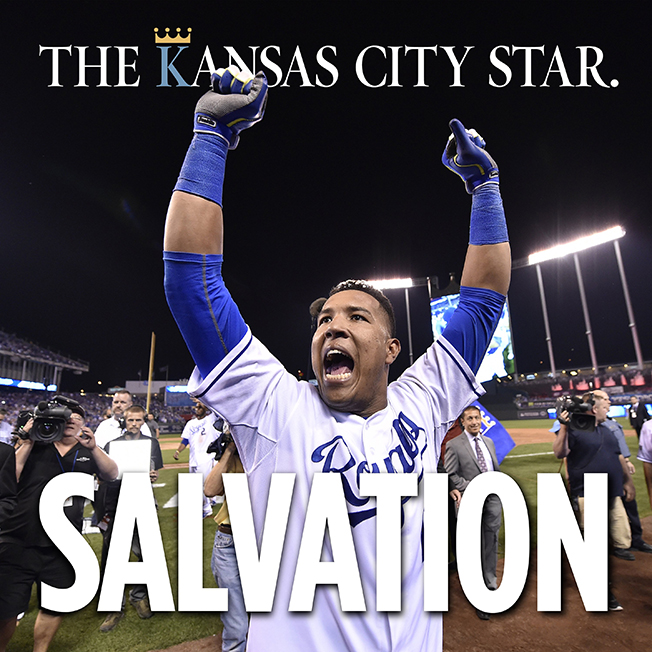
CPoY: Why did you choose and continue to pursue photography?
Sleezer: I chose photography at first because of the process involved. Take the picture and then spend time in the darkroom with chemicals to make the picture appear. The transition to photojournalism for me started as a photographer in the Army in the late 1970s. After photography training and a year at my first post, I was given the opportunity to be assigned to the post newspaper at Ft. Hood, Texas. That exposure to a weekly newspaper, and contact with outside photojournalists coming to the fort, set me on the way to being a newspaper photographer. After the Army in 1980, I stringed and worked for a small daily in Olathe, Kansas, before deciding to attend Kansas State University for a degree in Mass Communication and continue working for the Collegian, a daily student newspaper on campus.
CPoY: How does one develop a personal photographic style?
Sleezer: I've always thought developing a photographic style for a young photographer means studying other peoples styles, and trying to figure out how that photographer makes their pictures. Lighting, lens selection and angle of view, along with how the photographer put themselves in a particular situation, are ways of learning about a photographers style. Copying others styles in different situations helps a photographer to eventually develop their own style. I think that styles change as the situation the photographer puts themselves in change.
CPoY: How has the medium of photography changed for you since entering cPOY?
Sleezer: The skill set that photographers need these days have changed slowly over the years since my CPoY days. Getting wrapped up in the technology and allowing it to dictate how a photographer sees is very dangerous. The end result is the same now as it has always been, a photograph that tells a story about a particular person, event or place, for the public to experience. How we get there has changed, and photographers need to accept the change and see how the technology can add to their story telling.
CPoY: What advice do you have for student-photographers on entering photo contests?
Sleezer: Student photographers should enter and use photo contests to do two things. One, is to help gauge their work against others of similar experience. The photojournalism world is very competitive and it will give them an idea of where improvement is needed and if this is the correct field to spend their lives in. Second, is to further their career opportunities. CPoY on a resume will still open doors but will not automatically guarantee a job. A body of work, including still images, published work, video and participation in social media, will be needed to secure work.
Interview conducted by T.J. Thomson and Alex Scott.
CPoY: What impact did winning cPOY have on your work or professional career?
Eich: Winning cPOY was incredibly formative because it opened the door to National Geographic, a client that I still enjoy hearing from occasionally. cPOY introduced me to a lot of wonderful people, not only at Nat Geo but throughout the industry. It helped to put my work out there in a way I'd never been able to before and aided in the start of my freelance career, which proved to be incredibly helpful because less than a year later I was welcoming my first daughter into the world.
CPoY: What is the latest photo project you've been working on?
Eich: There isn't one particular project I've been working on ... since CPoY I worked more on "Carry Me Ohio" before moving to Virginia in 2009. In 2010 I started a project called "Sin & Salvation in Baptist Town" about a town in Mississippi which is ongoing as well as another chapter called "The Seven Cities" about my home in Virginia. I continuously photograph family and my daily life.
Here are a few 6x7 images from this year made while working on the Baptist Town project as well as "The Invisible Yoke" and my graduate studies at Hartford Art School's Photo MFA program.
CPoY: Why did you choose and continue to pursue photography?
Eich: Photography found me at a very early age, and it has always felt like the medium with which I can best communicate. This isn't to say that it's an easy path ... there are plenty of days where I wish I had a real job, and then other days where I realize that this is the best job in the world when it isn't taking me away from my family.
CPoY: How does one develop a personal photographic style?
Eich: Everyone is different, but style comes as a result of having something to say and knowing how it needs to be said.
CPoY: How has the medium of photography changed for you since entering cPOY?
Eich: Haha. Photography has been in a state of rapid change for some time now, but it has certainly been picking up the pace since 2006. For instance, I never really thought too much about Instagram or shooting assignments with my iPhone or having people "follow" my work through an outlet like that. I wasn't very worried about motion in 2006, though at this point I consider it an important addition to my skill set. That said, I still try to focus on image-making and let other more talented folks work on the editing end of things.
CPoY: What advice do you have for student-photographers on entering photo contests?
Eich: It's like fishing ... you won't catch anything if you're not out there, (i.e. can't win if you don't enter) and it's a numbers game. The more you put your work out there, are rejected, refine it, think about it, reformulate it, resubmit it, the more rapidly you are forced to confront your weaknesses and the more likely you are to succeed.
CPoY: What advice do you have for student photographers/young professionals who are ready to graduate or start in the field?
Eich: Don't turn your nose up at work ... always produce to the best of your ability and listen to your client's needs. There is no guarantee they will ever call you again. You are not just in the business of image-making, but in relationship-building. This carries through the people you photograph and the people you work for. Put your work out there, get torn apart, get better. There is no place for ego in this industry, be honest, genuine and open to feedback and be resourceful.
Interview conducted by T.J. Thomson and Alex Scott.
CPoY: What impact did winning cPOY have on your work or professional career?
Buchanan: I have to admit that when I was preparing my portfolio to send in to cPOY, I had been so focused that year on producing a portfolio that would be strong and effective and when I laid it all out on the day before I had to send it in, I was so depressed because I thought “It’s not there.”
But I came to realize that sometimes you can push too hard and you ultimately have to have faith in the work that you are doing and keep pushing forward. It reminded me of the great Ira Glass quote:
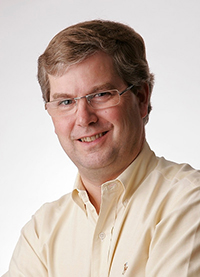
“Nobody tells this to people who are beginners, I wish someone told me. All of us who do creative work, we get into it because we have good taste. But there is this gap. For the first couple years you make stuff, it’s just not that good. It’s trying to be good, it has potential, but it’s not. But your taste, the thing that got you into the game, is still killer. And your taste is why your work disappoints you. A lot of people never get past this phase, they quit. Most people I know who do interesting, creative work went through years of this. We know our work doesn’t have this special thing that we want it to have. We all go through this. And if you are just starting out or you are still in this phase, you gotta know its normal and the most important thing you can do is do a lot of work. Put yourself on a deadline so that every week you will finish one story. It is only by going through a volume of work that you will close that gap, and your work will be as good as your ambitions. And I took longer to figure out how to do this than anyone I’ve ever met. It’s gonna take awhile. It’s normal to take awhile. You’ve just gotta fight your way through.”
Ultimately the CPoY did give me some assurance that I was headed in the right direction and to keep pushing forward and that maybe I wasn’t as bad as I thought at the time.
CPoY: What is the latest photo project you've been working on?
Buchanan: My life is a true variety of work that ranges from editorial to corporate to events and I wish I could say that editorial was still a big part of my business but unfortunately there is less space and pay for it so I am still applying my experience and skills in other directions, but at it’s root, it’s just photojournalism applied to different ends.
This last weekend I was out in LA working with Dan Dry (POY winner back in the late 70s for the Courier-Journal) and working with his team that covers the Breeders’ Cup Thoroughbred World’s Championships, which he and I have covered since the first races in 1984. It’s a test of sports photography, human interest and all on tight deadlines…all the things I still love to this day.
CPoY: Why did you choose and continue to pursue photography?
Buchanan: I love the variety. In everything about photojournalism, there is always something new. And even if there isn’t, it’s up to YOU to find something fresh.
I always admired the staff photographers who were professional enough that even though they were being sent out to photograph the same event that they had photographed time and again, they still came back with something new and innovative. I always vowed that I didn’t want to become one of those photographers that became burned out and bitter and lost the drive to always find something new or fresh. One of my teacher’s, Jack Corn would always say “You’re only as good as your last frame.” Wise words.
CPoY: How does one develop a personal photographic style?
Buchanan: When you start out, you look at others work and try to figure out how they did it. Sometimes you mimic it, sometimes you start to see things from their perspective so, like a piece of clothing, you have to try it on, but it doesn’t necessarily mean it’s your style or you’ll buy it.
You have to take a variety people’s of advice on composition and framing and then start to add your own knowledge of a topic or event and lay that on top of endeavoring to create images that can have more complexity while being simple and straight forward. Balance all those things and you are just beginning to develop a style. A mix of technique, knowledge, insight, and simplicity that combine to make the viewer feel they are right there and a part of the scene; immersed in the scene that they immediately understand it and yet there is more complexity there that they want to study the photo more. Then I think if you are achieving any of these things, you are starting to develop a style that is your own.
CPoY: How has the medium of photography changed for you since entering CPoY?
Buchanan: I think it has changed in some ways: technologically and with some more tools to use, but fundamentally, it’s still about making great photos that grab people’s attention and convey a message quickly, concisely and with depth and conviction.
Yes, it is very immediate and can be around the world in seconds but it can get lost in a lot of chatter. So getting attention for your work can be good and bad.
CPoY: What advice do you have for student-photographers on entering photo contests?
Buchanan: I would say that early in your career it is probably best to go with simple, direct and clean. With time your work will gain more depth and have more complexity. Like young writers who are starting out, their work and success is usually concise, directed and spare of too many words. So maybe your photography should be the same. Direct, concise and not too much clutter and focusing on making photos that put your viewers right in the middle of your images. You can usually succeed with that same formula as a writer.
CPoY: What advice do you have for student photographers/young professionals who are ready to graduate or start in the field?
Buchanan: I recently saw a video interview of Gregory Heisler; his point being that business part of photography and the medium where it is used is always changing that what it was like for me will not be the same as it will be for them. He points out that relationships are important in building a career and also that having a vision of your own to become successful but yet be true to yourself. It’s a great, must see interview.
Always push yourself to find something interesting in whatever you do, no matter how boring or mundane the assignment…and the more you shoot what you know and what you love, it will help you be the best at what you do. Always be curious and want to learn more and it will inform your images and yourself. Remember, you only as good as your last frame…
Interviewed conducted by T.J. Thomson and Alex Scott.